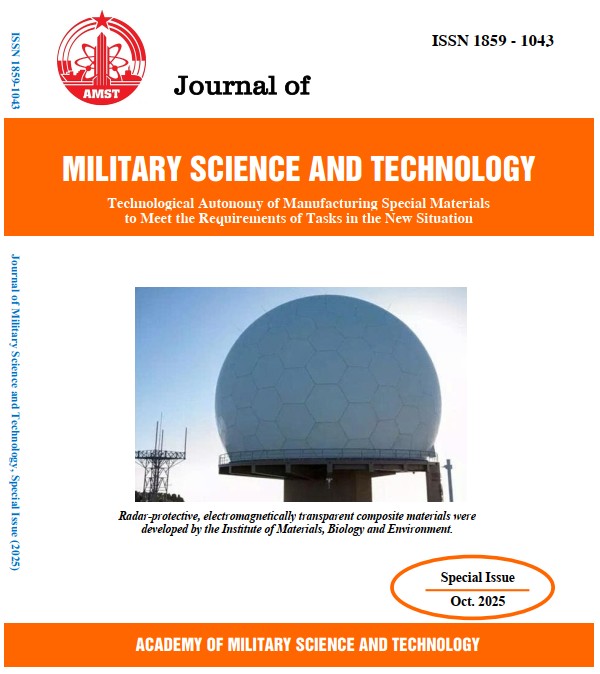Tổng hợp hydroxyl-terminated polybutadiene bằng phương pháp oxy hóa-khử sử dụng chất xúc tác ancol
DOI:
https://doi.org/10.54939/1859-1043.j.mst.IMBE.2025.70-75Từ khóa:
Hydroxyl-terminated polybutadiene (HTPB); Xúc tác ancol; Khử natri borohydride.Tóm tắt
Các phương pháp truyền thống để tổng hợp hydroxyl-terminated polybutadien (HTPB) có hàm lượng cis-1,4 cao thường đòi hỏi các quá trình oxy hóa-khử nhiều bước, vốn bị hạn chế do khả năng hòa tan kém của natri borohydrid trong các dung môi có độ phân cực thấp, dẫn đến hiệu suất thấp trong quá trình khử aldehyde-terminated polybutadiene (ATPB). Nghiên cứu này giới thiệu phương pháp tổng hợp one-pot sử dụng chất xúc tác alcohol để nâng cao hiệu quả khử ATPB thành HTPB. Kết quả nghiên cứu cho thấy, ethanol cải thiện rõ rệt hiệu suất phản ứng khử, nhóm carbonyl chuyển thành hydroxyl gần như hoàn toàn trong 15 phút ở 30 oC. HTPB thu được có hàm lượng cis-1,4 khoảng 95%, với khối lượng phân tử khoảng 4.880 g.mol-1, chỉ số hydroxyl là 0,78 mmol.g-1 và nhiệt độ thủy tinh hóa Tg = -92,1 oC.
Tài liệu tham khảo
[1]. L. T. DeLuca et al., “Characterization of HTPB-based solid fuel formulations: Performance, mechanical properties, and pollution”, Acta Astronautica, 92(2), pp. 150–162, (2013).
[2]. V. Sekkar et al., “Pot life extension of hydroxyl terminated polybutadiene based solid propellant binder system by tailoring the binder polymer microstructure”, Journal of Macromolecular Science, Part A, 54(3), pp. 171–175, (2017).
[3]. Q. Zhou et al., “Preparation of Hydroxyl-Terminated Polybutadiene with High Cis-1,4 Content”, Industrial & Engineering Chemistry Research, 53(46), pp. 17884–17893, (2014).
[4]. J. C. Brosse et al., “Hydroxyl-terminated polymers obtained by free radical polymerization - Synthesis, characterization, and applications”, in Catalytical and Radical Polymerization, Springer Berlin Heidelberg, pp. 167–223, (1986).
[5]. J.-m. Chen et al., “Synthesis of hydroxyl-terminated polybutadiene possessing high content of 1,4-units via anionic polymerization”, Chinese Journal of Polymer Science, 28(5), pp. 715–720, (2010).
[6]. D. Meng et al., “Preparation of Hydroxyl-Terminated Polybutadiene by the Pyrolysis Method and Its Application in Polyurethane”, ACS Applied Polymer Materials, 6(14), pp. 8235–8243, (2024).
[7]. K. Tanemura, “Reduction of aldehydes and ketones by a stoichiometric amount of NaBH₄ using a small amount of MeOH or EtOH”, Results in Chemistry, 4, p. 100486, (2022).
[8]. K. Ramya et al., “Hydrogen production by alcoholysis of sodium borohydride”, International Journal of Energy Research, 37(14), pp. 1889–1895, (2013).
[9]. H. C. Brown et al., “A Study of Solvents for Sodium Borohydride and the Effect of Solvent and the Metal Ion on Borohydride Reductions”, Journal of the American Chemical Society, 77(23), pp. 6209–6213, (1955).
[10]. Y. Tanaka et al., “Characterization of diene polymers. I. Infrared and NMR studies: Nonadditive behavior of characteristic infrared bands”, Journal of Polymer Science Part A-2: Polymer Physics, 9(1), pp. 43–57, (1971).
[11]. D. Papp et al., “A Complementary Multitechnique Approach to Assess the Bias in Molecular Weight Determination of Lignin by Derivatization-Free Gel Permeation Chromatography”, Analytical Chemistry, 96(26), pp. 10612–10619, (2024).







